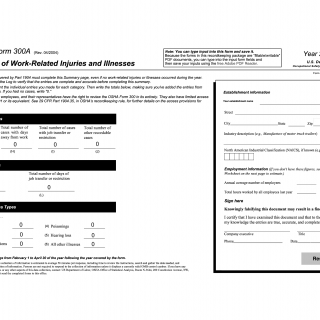OSHA Form 300A. Summary of Work-Related Injuries and Illnesses
OSHA Form 300A, Summary of Work-Related Injuries and Illnesses, is a form used by employers to report work-related injuries and illnesses that occurred in the previous year. The main purpose of this form is to provide a summary of the workplace injury and illness data to the Occupational Safety and Health Administration (OSHA).
The form consists of three parts:
- Part 1 - Establishment Information: This part includes the name of the establishment, the address, and the industry code.
- Part 2 - Summary of Work-Related Injuries and Illnesses: This part includes the number of cases that occurred in the previous year, the number of days away from work, the number of job transfers or restrictions, and the number of deaths.
- Part 3 - Certification: This part requires the signature of a company executive certifying that the information is accurate and complete.
The important fields to consider when compiling Form 300A are the number of cases, the number of days away from work, and the number of job transfers or restrictions. The parties involved in this form are the employer and OSHA.
When compiling the form, the data required includes the number of work-related injuries and illnesses, as well as the number of days away from work, job transfers or restrictions, and deaths. Additionally, a log of work-related injuries and illnesses, Form 300, must be attached to the form.
Application examples of Form 300A include reporting work-related injuries and illnesses that occurred in the previous year. The practice and use cases of this form are to ensure that employers are providing a safe and healthy workplace for their employees.
Strengths of this form include promoting workplace safety and health and providing valuable data to OSHA. Weaknesses of this form include the potential for underreporting or misreporting of injuries and illnesses.
An example of a related form is Form 300, Log of Work-Related Injuries and Illnesses, which is used to record individual cases of work-related injuries and illnesses. An alternative form is Form 301, Injury and Illness Incident Report, which is used to provide additional details about individual cases of work-related injuries and illnesses. The differences between Form 300A and Form 300 are that Form 300A is a summary of work-related injuries and illnesses, while Form 300 is a log of individual cases. The difference between Form 300A and Form 301 is that Form 300A is a summary of work-related injuries and illnesses, while Form 301 provides additional details about individual cases.
Submitting Form 300A involves posting the form in a visible location in the workplace from February 1 to April 30 of each year. The form should also be stored with the employer's OSHA records.
Overall, Form 300A is an important form for promoting workplace safety and health and providing valuable data to OSHA.

